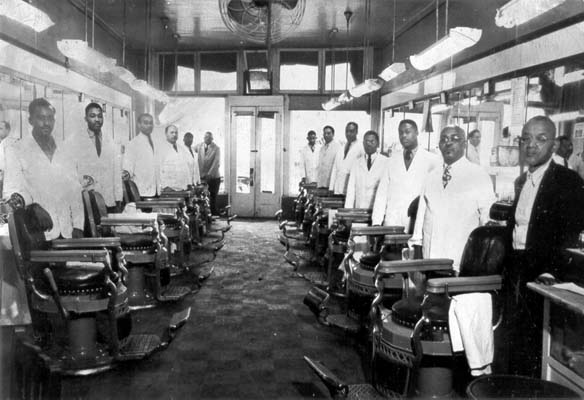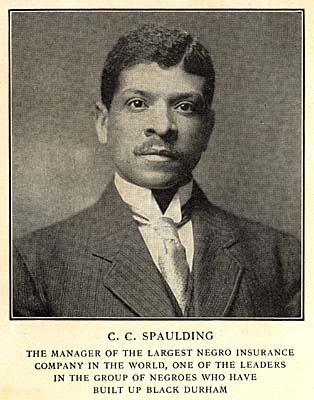
From Documenting the American South, "The Upbuilding of Black Durham: The Success of the Negroes and Their Value To A Tolerant And Helpful Southern City," by W. E. Burghardt Du Bois

THE UPBUILDING OF BLACK DURHAM
DURHAM, N. C., is a place which the world instinctively associates with tobacco. It has, however, other claims to notice, not only as the scene of Johnston's surrender at the end of the Civil War but particularly today as the seat of Trinity College, a notable institution.
It is, however, because of another aspect of its life that this article is written: namely, its solution of the race problem. There is in this small city a group of five thousand or more colored people, whose social and economic development is perhaps more striking than that of any similar group in the nation.

The Negroes of Durham County pay taxes on about a half million dollars' worth of property or an average of nearly $500 a family, and this property has more than doubled in value in the last ten years.
A cursory glance at the colored people of Durham would discover little to differentiate them from their fellows in dozens of similar Southern towns. They work as laborers and servants, washerwomen and janitors. A second glance might show that they were well represented in the building trades and it would arouse interest to see 500 colored girls at work as spinners in one of the big hosiery mills.

The chief interest of any visitor who stayed long enough to notice, would, however, centre in the unusual inner organization of this group of men, women, and children. It is a new "group economy" that characterizes the rise of the Negro American -- the closed circle of social intercourse, teaching and preaching, buying and selling, employing and hiring, and even manufacturing, which, because it is confined chiefly to Negroes, escapes the notice of the white world.
In all colored groups one may notice something of this coöperation in church, school, and grocery store. But in Durham, the development has surpassed most other groups and become of economic importance to the whole town.

There are, for instance, among the colored people of the town fifteen grocery stores, eight barber shops, seven meat and fish dealers, two drug stores, a shoe store, a haberdashery, and an undertaking establishment. These stores carry stocks averaging (save in the case of the smaller groceries) from $2,000 to $8,000 in value.
This differs only in degree from a number of towns; but black Durham has in addition to this developed five manufacturing establishments which turn out mattresses, hosiery, brick, iron articles, and dressed lumber. These enterprises represent an investment of more than $50,000. Beyond this the colored people have a number of financial enterprises among which are a building and loan association, a real estate company, a bank, and three industrial insurance companies.

The coöperative bonds of the group are completed in social lines by a couple of dozen professional men, twenty school teachers, and twenty churches.
All this shows an unusual economic development and leads to four questions: (1) How far are these enterprises effective working businesses? (2) How did they originate? (3) What has been the attitude of the whites? (4) What does this development mean?

The first thing I saw in black Durham was its new training school -- four neat white buildings suddenly set on the sides of a ravine, where a summer Chautauqua for colored teachers was being held. The whole thing had been built in four months by colored contractors after plans made by a colored architect, out of lumber from the colored planing mill and ironwork largely from the colored foundry. Those of its two hundred and fifty students who boarded at the school, slept on mattresses from the colored factory and listened to colored instructors from New York, Florida, Georgia, Virginia, Pennsylvania, New Jersey, and North Carolina. All this was the partially realized dream of one colored man, James E. Shepard. He formerly worked as secretary for a great Christian organization, but dissatisfied at a peculiarly un-Christian drawing of the color line, he determined to erect at Durham a kind of training school for ministers and social workers which would be "different."

One morning there came out to the school a sharp-eyed brown man of thirty, C. C. Spaulding, who manages the largest Negro industrial insurance company in the world. At his own expense he took the whole school to town in carriages to "show them what colored people were doing in Durham."
Naturally he took them first to the home of his company -- "The North Carolina Mutual and Provident Association," an institution which is now twelve years old. One has a right to view industrial insurance with some suspicion and the Insurance Commissioner of South Carolina made last year a fifteen days thorough examination of this enterprise. Then he wrote: "I can not but feel that if all other companies are put on the same basis as yours, that it will mean a great deal to industrial insurance in North and South Carolina, and especially a great benefit to the Negro race."

The company's business has increased from less than a thousand dollars in 1899 to an income of a quarter of a million in 1910. It has 200,000 members, has paid a half million dollars in benefits, and owns its office buildings in three cities.
Not only is the society thus prosperous at present but, it is making a careful effort to avoid the rocks upon which the great colored order of "True Reformers" split, by placing its business on an approved scientific basis. It is installing a new card bookkeeping system, it is beginning to construct morbidity and mortality records, and its manager is a moving spirit of the Federated Insurance League for colored societies which meets annually at Hampton, Va.
The Durham office building of this company is neat and light. Down stairs in the rented portion we visited the men's furnishing store which seemed a business-like establishment and carried a considerable stock of goods. The shoe store was newer and looked more experimental; the drug store was small and pretty.

From here we went to the hosiery mill and the planing mill. The hosiery mill was to me of singular interest. Three years ago I met the manager, C. C. Amey. He was then teaching school, but he had much unsatisfied mechanical genius. The white hosiery mills in Durham were succeeding and one of them employed colored hands. Amey asked for permission here to learn to manage the intricate machines, but was refused. Finally, however, the manufacturers of the machines told him that they would teach him if he came to Philadelphia. He went and learned. A company was formed and thirteen knitting and ribbing machines at seventy dollars apiece were installed, with a capacity of sixty dozen men's socks a day. At present the sales are rapid and satisfactory, and already machines are ordered to double the present output; a dyeing department and factory building are planned for the near future.
The brick yard and planing mill are part of the general economic organization of the town. R. B. Fitzgerald, a Northern-born Negro, has long furnished brick for a large portion of the state and can turn out 30,000 bricks a day.

To finance these Negro businesses, which are said to handle a million and a half dollars a year, a small banking institution has been started. The "Mechanics' and Farmers' Bank" looks small and experimental and owes its existence to rather lenient banking laws. It has a paid-in capital of $11,000 and it has $17,000 deposited by 500 different persons.
A careful examination of the origin of this Durham development shows that in a peculiar way it is due to a combination of training, business capacity, and character. The men who built 200 enterprises are unusual, not because the enterprises in themselves are so remarkable, but because their establishment met peculiar difficulties. To-day the white man who would go into insurance or haberdashery or hosiery making gathers his capital from rich men and hires expert managers who know these businesses. The Negro gathers capital by pennies from people unused to investing; he has no experts whom he may hire and small chance to train experts; and he must literally grope for success through repeated failure.

Three men began the economic building of black Durham: a minister with college training, a physican with professional training, and a barber who saved his money. These three called to their aid a bright hustling young graduate of the public schools, and with these four, representing vision, knowledge, thrift, and efficiency, the development began. The college man planned the insurance society, but it took the young hustler to put it through. The barber put his savings into the young business man's hands, the physician gave his time and general intelligence. Others were drawn in -- the brickmaker, several teachers, a few college-bred men, and a number of mechanics. As the group began to make money, it expanded and reached out. None of the men are rich -- the richest has an income of about $25,000 a year from business investments and eighty tenements; the others of the inner group are making from $5,000 to $15,000 -- a very modest reward as such rewards go in America.

Quite a number of the colored people have built themselves pretty and well-equipped homes -- perhaps fourteen of these homes cost from $2,500 to $10,000; they are rebuilding their churches on a scale almost luxurious, and they are deeply interested in their new training school. There is no evidence of luxury -- a horse and carriage, and the sending of children off to school is almost the only sign of more than ordinary expenditure.

If, now, we were considering a single group, geographically isolated, this story might end here. But never forget that Durham is in the South and that around these 5,000 Negroes are twice as many whites who own most of the property, dominate the political life exclusively, and form the main current of social life. What now has been the attitude of these people toward the Negroes? In the case of a notable few it has been sincerely sympathetic and helpful, and in the case of a majority of the whites it has not been hostile. Of the two attitudes, great as has undoubtedly been the value of the active friendship of the Duke family, General Julian S. Carr, and others, I consider the greatest factor in Durham's development to have been the disposition of the mass of ordinary white citizens of Durham to say: "Hands off -- give them a chance -- don't interfere." As the editor of the local daily put it in a well deserved rebuke to former Governor Glenn of North Carolina: "If the Negro is going down, for God's sake let it be because of his own fault, and not because we are pushing him." (source: Documenting The American South)

your blog is very helpful for visitors and tourists thanks.
ReplyDeletehair extensions durham
professional relaxers